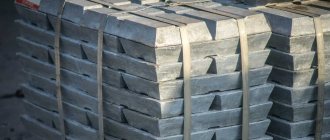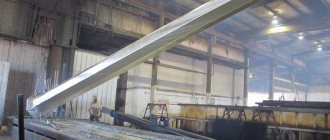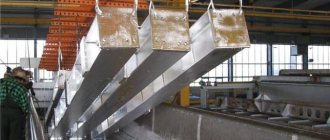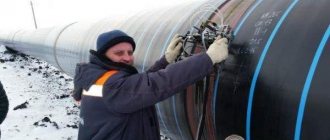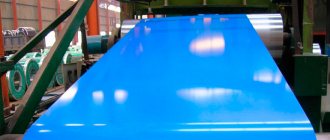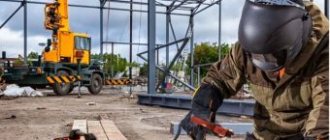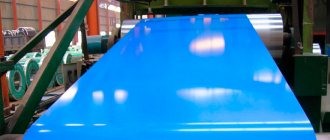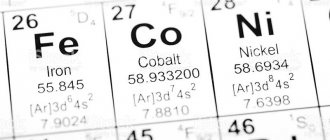Hot-dip galvanizing is a method of coating the surface of a metal product with a layer of zinc, second in popularity only to galvanic galvanizing technology. Meanwhile, in terms of the cost of implementation, as well as the durability of the formed zinc coatings, this method is superior to electrochemical galvanizing.
Test results of bolts with different galvanization in hydrochloric acid solution
You can familiarize yourself with the GOST requirements for hot-dip galvanized coatings by downloading the document in pdf format from the link below.
GOST 9.307-89 Unified system of protection against corrosion and aging. Hot zinc coatings. General requirements and control methods
Introduction
Metal products are used everywhere. But, unfortunately, nothing is eternal in the world! Even metal is destroyed naturally, leading to billions in losses. Therefore, it is not surprising that scientists are developing various technologies that can protect steel structures and products from corrosion.
Hot galvanizing is the simplest and most popular way to combat rust. In this article we will talk in detail about the technology of applying hot zinc, its strengths and weaknesses.
Hot-dip galvanizing: what is it and a little history
Hot-dip galvanizing is the coating of a metal product with a layer of zinc to protect against corrosion. Hot-dip galvanizing is always performed by immersing the part in a bath of molten zinc. Metal temperature is 450 degrees Celsius.
The founder of hot-dip galvanizing is Paul Jacques Malouin (French chemist). It was he who, in 1742, came up with the idea of “bathing” steel parts in molten zinc. Paul announced his discovery at the Royal Academy.
And only after almost a hundred years this technology was modernized and patented. Sorel was able to achieve such success in 1836, proving the effectiveness of the method through numerous studies.
Installation of galvanized pipes and its features
When installing galvanized pipes, it is better not to use welding. If the direct heat is too strong, the coating will fade. Also, when welding, zinc vapors are released - harmful to health. It is required to work with special means and in compliance with safety precautions.
If you do use welding, pay attention to what electrodes are used in the process. You will also need fluxes that prevent overheating of the working material. In this way, it is possible to provide reliable protection against zinc burnout and loss of performance characteristics.
Many manufactured galvanized pipes are threaded. In this way, it is possible to create sealed pipelines without welded joints. To further improve the tightness, use both nitro paint and paint.
Properties of zinc coating. What products is it used for?
Zinc is a barrier coating. It protects against rust when iron comes into contact with the environment. It has been proven that hot-deposited zinc effectively protects products from 20 to 120 years. In addition, elements and structures do not need to be repainted, which is a real savings!
Typically, hot-dip galvanizing is used to coat large, simple-shaped products. These can be pipes, angles, sheets, beams, wire, etc. This method is not effective for products with threads, small holes, or products with complex shapes.
Areas of application
Metal structures used outdoors need protection. Hot zinc coating is used for the following products:
- power line supports, especially high-voltage ones;
- anti-corrosion coating of the lower part of the ship's hull;
- metal structures of bridges and pipelines;
- street lighting poles;
- building frames;
- steps of stairs;
- railings, balcony railings and other building elements;
- ventilation system pipes.
The method of hot-dip galvanizing metal is used for pipelines and various elements of garden and facade design.
Hot-dip galvanizing: description of process technology
After all, the galvanizing process is quite capacious and takes place in several stages.
Stage 1 - Degreasing
Before proceeding with galvanizing, it is necessary to prepare the surface of the target product. First, the base metal must be degreased, because it may have oily stains, lubricant residues and various organic contaminants. To degrease steel, special alkaline or acidic solutions are used. There is no universal remedy; experts choose it based on the level of contamination of the product. It must be said that the optimal temperature for this process is 60-80ºС.
Stage 2 - Washing
This procedure should not be neglected! It is used to ensure that all residues of fat, foam and degreasing agents are removed. The second reason is that the solution from the degreasing bath should not get into subsequent baths.
Stage 3 - Etching
This operation allows you to remove rust and scale from the part before galvanizing. It needs to be immersed in a bath containing a solution of hydrochloric acid with a concentration of 120-210 g/l. By the way, the air temperature in the workshop at this moment should be within 20 - 25ºС.
Keep in mind that hydrochloric acid can harm the metal itself, so special inhibitors should be added to the solution - additives that allow the acid to dissolve only rust and scale without damaging clean steel.
Stage 4 - Washing
After etching, particles of the solution components remain on the surface. They need to be removed. Therefore, washing is needed again.
Stage 5 - Fluxing
It sounds paradoxical, but after washing, thin iron oxides will again appear on the product. They can be eliminated by fluxing. This operation allows you to obtain a passive film on the surface of the product, which protects against subsequent oxidation and provides excellent wetting at the time of galvanizing.
To create a solution, zinc and ammonium chlorides are used. You can give an example of one of the popular compositions - 55.4% NH4Cl, 6% glycerol, 38.4% ZnCl2. For fluxing, a temperature of around 60ºC is required. The flux concentration in the solution should be 410 - 590 g/l and it must be kept under constant control! Periodically it is necessary to clean the bathtub by adding hydrogen peroxide to it. Ferric iron salts will remain at the bottom. The resulting sediment is sent to settling tanks and then filtered.
Stage 6 - Drying
If a wet product is immersed in molten zinc, the remaining water will begin to evaporate, causing “micro-explosions.” As a result, it will be possible to observe untreated or unevenly coated areas!
In addition, the wet product will begin to lower the temperature of the molten zinc. This means that more energy will be required to maintain it. Therefore, it is so important to initially place the product in a drying oven at a temperature of about 100ºC.
Stage 7 - Galvanizing
If you want to end up with a product with a high-quality protective layer, then there are a number of factors to consider. Namely:
- the quality of the materials, as well as the temperature to which they were heated;
- time and speed of immersion of the product;
- the speed at which the products are removed from the bath and the method of cooling them.
Note that when dipped into the bath, the flux begins to melt, thereby ensuring the wettability of the molten zinc. The speed at which the part is lowered is critical. If it is insufficient, the flux will have time to melt ahead of time and oxides will remain on the surface. And if you immerse quickly, the flux will not melt and the quality of adhesion of the zinc to the product will sharply deteriorate.
The optimal technology for hot-dip galvanizing metal involves keeping the product in a bath of melt for 3 to 10 minutes. Keep in mind that during the above process, a layer of slag appears on the surface of the melt in the bath. It must be removed using a special scraper before you begin to lift the product. Otherwise, this slag will settle on the galvanized surface of the part.
But the thickness of the metal layer will depend directly on the lifting speed of the product. It's all about the rate of crystallization of the melt. This means that the slower the galvanized part rises, the thicker the protective layer. It is worth considering the dimensions and shape of the product. Based on them, the speed and inclination of the climb are calculated individually.
Stage 8 - Drying
At the end, the metal product is left to cool. This procedure is carried out in two stages. First in the open air in the workshop, then in a warm warehouse.
Coating quality control, rejection criteria
After completion of work, the product should be inspected for flaws and defects. The quality of hot-dip galvanizing is regulated by GOST 9.307-89. The following criteria must be met.
- The zinc layer must be continuous;
- The coating should be matte dark gray or silver-glossy;
- Sagging is not allowed on the surface of a galvanized product. Insertion of hartzink (sediment), if present, is no more than 2 mm.
- GOST allows both smooth and rough coatings;
A number of signs that are not considered defects:
- rippling and minor surface irregularities;
- rainbow shades or spots in light gray tones;
- minor metal scratches of the protective layer if the base metal is not visible to the naked eye.
In addition, if there are areas with gaps, the area of which does not exceed 2% of the total, they can be treated with cold galvanizing compounds or by thermal spraying. Similarly, areas not coated with zinc, up to two centimeters in diameter, are eliminated.
According to the above-mentioned GOST, the thickness of the protective zinc layer should be in the range of 40 - 200 microns. Or it is written in the product passport, based on its features and operating conditions.
This parameter should be checked before chroming (applying an additional protective film over zinc) or applying preservative lubricants. There are two ways:
- using magnetic thickness gauges;
- Metallographic analysis on witness samples.
And finally, the quality of adhesion of the zinc layer is checked. Particular attention is paid to areas with threads or welding points! To control adhesion, one of four methods is used:
- scratch grid;
- heat;
- brushing;
- blows with a rotary hammer.
Dew point dependence on temperature and relative humidity
It is important to note that each subsequent layer of coating can be applied only after the previous layer has completely dried.
An anti-corrosion composition containing zinc is applied to the cleaned surface. To prevent the formation of condensation, the compositions should be applied taking into account the manufacturers' recommendations regarding operating temperatures.
Zinc paint is applied in several layers. In this case, each subsequent layer is applied only after the previous one has completely dried. Airless technology or the use of pneumatic spray guns can speed up paint drying.
The quality of the applied protective coating, as well as the level of adhesion, is checked using special measuring devices. A visual inspection is also carried out to identify areas that need rework and other coating defects.
Advantages and disadvantages of hot-dip galvanizing
Advantages:
- excellent corrosion resistance of the resulting coating in neutral environments;
- acceptable price;
- high process productivity;
- good thermal conductivity of the coating;
- The galvanized layer does not lose its protective properties even if it is damaged.
Flaws:
- It is impossible to apply thin layers of zinc, galvanize threads, small holes, and complex-profile products;
- the technology is not suitable for small piece orders;
- it is difficult to maintain uniform coverage;
- high zinc consumption;
- unpresentable appearance – gray matte color, not suitable for decorative items;
- It is impossible to coat products that exceed the dimensions of the bath for immersion.
GALVANIZED
— Up to an outer diameter of 4”, two pipes are processed simultaneously.
— Pipes with a diameter of more than 4” are processed one at a time.
— When processing one or two pipes, all pipes exit from the same side.
— Internal pipe blowing can be done both horizontally and at an angle.
— The immersion unit is replaceable for quickly changing pipe sizes.
- The same screws are suitable for driving pipes with diameters from 2" to 3/8" to avoid screw replacement.
Cost of hot galvanizing. Factors influencing price formation.
The cost of the service is individual and depends on a number of parameters. This takes into account the dimensions, shape of the product, complexity of processing, and amount of work. There are also additional “options” for which you need to pay extra. For example, creating technological holes or “ears” for fastenings, removing old coating, etc.
One of the main parameters of price formation will be zinc consumption; the higher it is, the more expensive it is.
In 2022, the price in Russia for hot galvanizing will be in the range from 22,000 to 40,000 rubles per ton. Please note that many companies charge an additional fee for urgency. The cost of galvanizing parts weighing up to 100 kilograms, light but large products or those that have cavities, pockets, corners is separately discussed. Here the price can vary from 30,000 to 50,000 rubles per ton.
Galvanizing services in Moscow, advantages of contacting our company
But what if processing is needed not for two or three parts, but for a serial batch, and it needs to be done in the shortest possible time? Our workshop offers a full range of metal galvanizing services: from preparatory work to shipment of finished products to the customer’s warehouse. Contact us and we will:
- We will promptly respond to your request,
- We will make a discount for volume,
- We will carry out high-quality galvanizing in Moscow in compliance with all technological requirements,
- We will provide control at all stages of processing,
- We will complete the order strictly by the time specified in the contract,
- We will provide a guarantee for the work performed.
